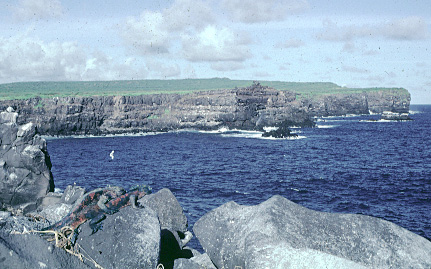|
Description of the Galapagos Islands Isla Espanola  | | The South Cliffs of Isla Espanola. Picture source: http://www.geo.cornell.edu/geology/GalapagosWWW/Espanola.html |
Espanola, also known as Hood, is one of the smaller Galapagos Islands, measuring 7 by 14 km and reaching an elevation of just over 200 m. Espanola is the oldest Galapagos Island, or at least the island on which the oldest lavas have been found. These lavas are 3.4 million years old as determined by K-Ar dating. For some time, it was thought that the evolution of the unique fauna and flora of the Galapagos must have occurred within this time (i.e., the last 3 and 1/2 million years). It is now clear, however, that there have been islands in the Galapagos for much longer. An eight million year old flat top seamount located several hundred km to the southeast on Carnegie Ridge was once a Galapagos Island and has been carried eastward by the motion of the Nasca plate. Thus Espanola's age does not constrain the amount of time available for evolution. Indeed, there may have been islands in the Galapagos for 80 million years, plenty of time for the unique flora and fauna of the Galapagos to evolve.
Espanola appears to represent roughly the northern two thirds of a once larger volcano. The southern coast of the island is a vertical cliff 100 m or more high. This appears to be a fault scarp; the southern half of the volcano has been faulted into the sea. Other east-west faults can also been seen. Thus Espanola appears to have been subjected to the same tectonic processes that have disrupted Santa Cruz and Santa Fe.
Since it is low, Espanola is particularly dry and inhospitable. Without a reliable source of fresh water, it has not been settled and has not been as threatened by introduced mammals as some other islands. This is not to say, however, that its wildlife has not had problems. By 1959, only 12 females and 2 males of the distinctive saddleback tortoises of the Espanola race remained. This was too few to maintain a breeding population. In the early 1960's all these animals, as well as an additional male located zoo in the U.S., were brought to the Darwin Research Station and a captive breeding program begun. Thanks to this program, Espanola now has a growing population of young tortoises. Nests were observed in 1990 and hatchlings in 1991. By 1995, about 700 tortoises raised at Darwin Station had been returned to Espanola. The prognosis for this race is now quite good.
While inhospitable to terrestrial life, Espanola is a haven for seabirds. It has the largest known colony of waved albatrosses, magnificent birds of enormous wing span. The high southern cliffs provide the elevation these large birds need to take off. Many other bird, such as the red-billed tropic bird, may also be seen there. The Espa?la race of marine iguanas have particularly striking red coloration. In the northeast of the island at a site called the blowhole, wave energy focused by cracks in the rocks produces enormous gysers of seawater to the delight of onlookers.
|







